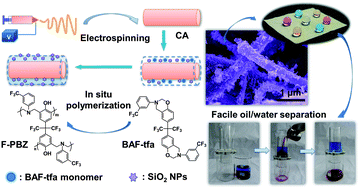An in situpolymerization approach for the synthesis of superhydrophobic and superoleophilic nanofibrous membranes for oil–water separation†
Abstract
Superhydrophobic and superoleophilic nanofibrous membranes exhibiting robust oil–water separation performance were prepared by a facile combination of electrospun cellulose acetate (CA) nanofibers and a novel in situ polymerized fluorinated polybenzoxazine (F-PBZ) functional layer that incorporated silica


 Please wait while we load your content...
Please wait while we load your content...